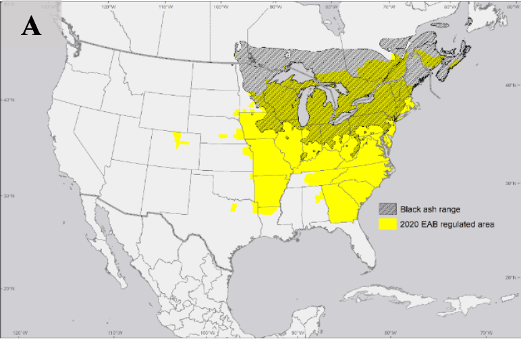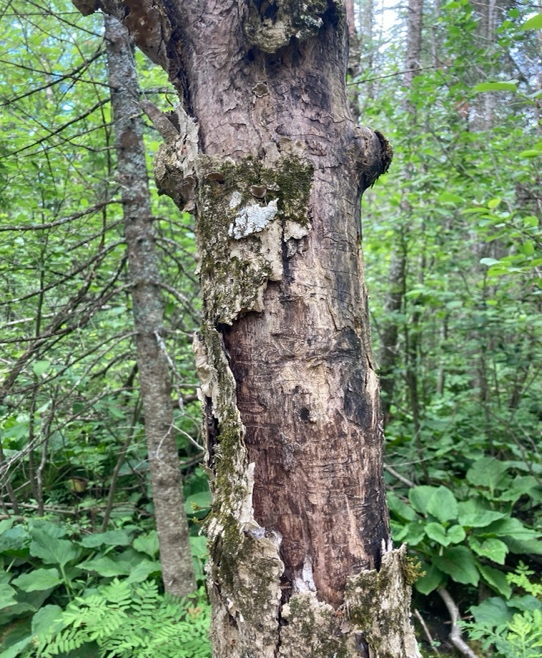
Black Ash: A Foundational Wetland and Cultural Keystone Species
Black ash (Fraxinus nigra Marshall), also known as brown or basket ash, is a unique tree that is most often found in wet, swampy forests and riparian forests that border streams, rivers, and lakes. Its native range extends across much of the north central and northeastern United States, and southeastern Canada1. Today, black ash is mostly found in northern portions of the Lake States (MN, WI, MI) as well as NY, PA, and ME. Black ash is an ecological foundational species because of its role in nutrient cycling and hydrological processes, and the habitat it provides for various birds and other animals in forests where it is dominant.
| State | Estimated Number of Black ash Stems | Percentage of Total Ash Species |
|---|---|---|
| New York | 26,500,000 | 6% |
| Minnesota | 302,500,000 | 78% |
| Wisconsin | 213,000,000 | 59% |
| Michigan | 159,000,000 | 46% |
| Pennsylvania | 1,500,000 | 1% |
| Maine | 45,500,000 | 32% |


Black ash is also considered a cultural keystone species for many American Indian and First Nations groups throughout its range.2,3 For generations, basketmaking families have created artistic and utilitarian baskets with splints from black ash sapwood. Black ash is also revered as a spiritual resource and a source of Indigenous medicines for several Indigenous groups.
Unfortunately, black ash is a highly preferred and vulnerable host for emerald ash borer in North America. Given the current distribution and the ongoing spread of EAB, there is concern that black ash could be lost from North American forests by mid-century.4,5 Loss of black ash overstory trees will likely affect wetland and riparian forest ecosystems and will directly impact the ways of life of Indigenous people who have been using black ash for basketry for millennia.2,6


More Information
Resources
From Tree to Basket: Black Ash Tree Basketry in the North Country
Click here to learn more about indigenous black ash basketry pratices and the traditions surrounding black ash.
Emerald Ash Borer Impacts on American Indian Communities
Emerald ash borer (EAB) infestation is a major concern for American Indian people. Many American Indian cultures and traditions rely on ash trees for the wood needed for making baskets, lacrosse sticks, pipe stems, flutes, and medicinal remedies. The ash tree is a central figure in some traditional and religious stories told by several American Indian tribes.
A Silent Killer
National Museum of the American Indian magazine, Spring 2020, "A Silent Killer", by Anne Bolen, pages 8-15, (copyright symbol) 2020 Smithsonian Institution, National Museum of the American Indian. Shared with permission.
Page References
- Gucker, C.L. 2005. Fraxinus nigra. In: Fire Effects Information System, [Online]. U.S. Department of Agriculture, Forest Service, Rocky Mountain Research Station, Fire Sciences Laboratory (Producer).
- Costanza, K.K.L., Livingston, W.H., Kashian, D.M., Slesak, R.A., Tardif, J.C., Dech, J.P., et al. 2017. The precarious state of a cultural keystone species: Tribal and biological assessments of the role and future of black ash. J. For. 115(5). 435-446. doi:10.5849/jof.2016-034R1.
- Diamond, A. K., & Emery, M. R. 2011. Black ash (Fraxinus nigra Marsh.): Local ecological knowledge of site characteristics and morphology associated with basket-grade specimens in New England (USA). Econ. Bot. 65(4). 422-426. doi:10.1007/s12231-011-9174-z.
- Siegert, N. W., McCullough, D. G., Luther, T., Benedict, L., Crocker, S., Church, K., and Banks, J. 2023. Biological invasion threatens keystone species indelibly entwined with indigenous cultures. Frontiers in Ecology and the Environment. In Press.
- Siegert, N. W., Engelken, P. J., & McCullough, D. G. 2021. Changes in demography and carrying capacity of green ash and black ash ten years after emerald ash borer invasion of two ash-dominant forests. For. Ecol. Manage. 494. 119335. doi:10.1016/j.foreco.2021.119335.
- Klooster W. S, Gandhi K. J. K, Long L. C., et al. 2018. Ecological impacts of emerald ash borer in forests at the epicenter of the invasion in North America. Forests 9: 250. doi:10.3390/f9050250.